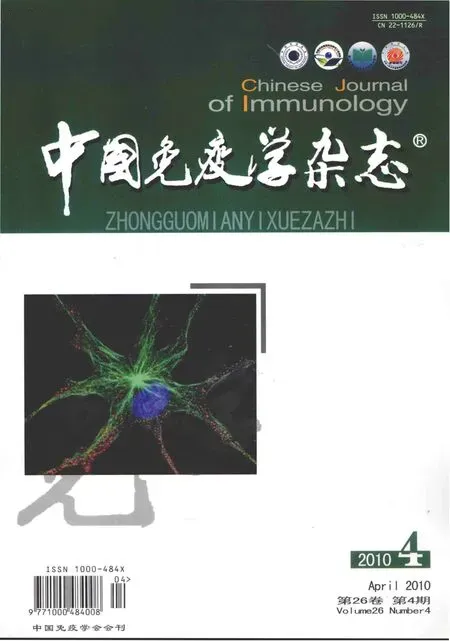Th22细胞的研究进展①
刘 昀 吴长有 (中山大学中山医学院免疫学教研室,广州 510080)
Th22细胞是最近发现的CD4+T细胞功能亚群,表达CCR6、CCR4和 CCR10,产生 IL-22和 IL-13,但是不产生 IFN-γ、IL-4和 IL-17,是独立于 Th1、Th2和Th17的细胞亚群。IL-6和TNF能够诱导初始CD4+T细胞向Th22细胞分化。TGF-β抑制Th22的分化。加入IL-1β后,诱导同时产生IL-17和IL-22的Th17细胞。AHR的激动剂可以促进Th22细胞的分化,而抑制Th17细胞的分化。Th22细胞主要参与皮肤的自稳调节和病理状态。在正常情况下,与其他细胞亚群互相调控,使机体处于平衡状态。在此拟就Th22的分化及功能做一综述。
1 IL-22的生物学特征和功能
2000年,Renauld等[1]用 IL-9刺激小鼠BW5147T淋巴瘤细胞后,发现其表达一种新的细胞因子,由于它与抗炎和免疫抑制因子IL-10二级结构非常相似,被命名为IL-TIF(Interleukin-10-related T cell-derived inducible factor),即“IL-10相关的T细胞衍生的可诱导因子”。随后,两个实验室同时鉴定出人的IL-TIF,重命名为白细胞介素22[2]。
IL-22在皮肤的防御中起着重要的作用。IL-22可以诱导β-抗菌肽2,3以及S100A7、S100A8、S100A9的生成。β-抗菌肽可以杀死细菌、病毒、真菌,激活肥大细胞和趋化未成熟DC细胞和记忆T细胞至伤口部位。S100A7、S100A8、S100A9也可以保护皮肤,防止病原入侵。IL-22还抑制角质细胞的分化和加强角质细胞的游走能力,使这些细胞形成一道防御屏障。
在啮齿枸橼酸杆菌(C.rodentium)感染所致肠炎和克雷白氏杆菌所致肺炎的小鼠感染模型中,证明IL-22起着重要的防御作用[3,4]。IL-22在病毒和真菌感染中也发挥作用。我们的研究表明,健康人外周血中存在一群白色念珠菌特异性CCR6+IL-22+CD4+记忆T细胞。慢性白色念珠菌感染病人外周血单个核细胞较之健康人群产生更高量的IL-22,并且病人外周血中白色念珠菌特异性IL-22+CD4+细胞频率增加[5]。
除感染性疾病,IL-22在自身免疫性疾病,如银屑病、Crohn's疾病、溃疡性结肠炎、类风湿性关节炎等疾病中表达也有所上调[6,7]。并且IL-22可以帮助损伤的组织器官修复[8,9]。可能是诱导急性反应蛋白如SAA、α 1抗胰蛋白酶的表达而起到保护作用。
2 IL-22受体及其信号转导
IL-22通过由IL-22R和IL-10R2两条链组成的异源双体受体复合物发挥其作用。IL-10R2也是IL-10、IL-26、IL-28和IL-29等受体的亚基,广泛表达于淋巴细胞和其他组织。IL-22R主要表达在皮肤、消化道、呼吸道等与外界相通的上皮组织。特别是在角质细胞、胰腺上高表达IL-22R。在骨髓、外周血单个核细胞、胸腺或脾脏都未检测到IL-22R。静息或激活的淋巴细胞也不表达IL-22R[10]。IL-22与IL-22R结合后,构象发生变化,与IL-10R2的结合位点暴露,与IL-10R2结合,从而引起信号转导。
在大鼠肝细胞瘤株中发现IL-22诱发JAK1和Tyk2的活化,进而引起STAT1,3,5上的酪氨酸残基的磷酸化。Wolk等[10,11]证明在人角质细胞,IL-22主要是引起STAT3的磷酸化。Andoh等[12]在研究结肠上皮下的肌纤维母细胞IL-22信号转导通路中,证明IL-22不仅能诱导STAT3的磷酸化,也能诱导 ERK1/2、JNK、p38 激 酶 和 Iκ B-α的 磷 酸 化。Ikeuchi等[13]证明在类风湿性关节炎患者滑液中的成纤维母细胞中,IL-22能诱导ERK1/2、p38激酶的磷酸化,但未检测STAT、JNK、NF-κ B 通路。
3 Th22细胞的分化
最初认为IL-22为Th1细胞因子,因为在Th1的极化条件下,IL-22的产生明显高于Th2的极化条件[14]。但随着研究的进展,人们认为IL-22为Th17细胞因子[15-18]。在Th17的极化条件下表达的IL-22明显高于Th1和Th2极化条件。IL-23或IL-6均可单独诱导初始CD4+T细胞产生IL-22。最近研究表明,表达CCR6、CCR10和CCR4的记忆性CD4+T细胞产生IL-22,而不产生 IFN-γ、IL-4和IL-17,是独立于Th1、Th2和Th17的细胞亚群。这群细胞参与皮肤的自稳调节和病理状态,被定义为Th22细胞[19,20]。
研究表明,IL-6和TNF可以诱导人初始CD4+T细胞向Th22细胞的分化,而TGF-β抑制Th22的分化。加入IL-1β后,诱导同时产生IL-17和IL-22的Th17细胞的分化[20]。在人的初始CD4+T细胞向Th17细胞的诱导分化条件下,芳烃受体(Aryl hydrocarbon receptor,AHR)的激动 剂 β-萘黄酮(β-naphthoflavone,βNF)可以促进IL-22产生细胞的形成,而抑制Th17细胞的分化,RORC mRNA表达下降。小鼠则与人存在差异,初始CD4+T细胞向Th17细胞的诱导分化条件下,βNF可以同时增加IL-22和IL-17产生细胞。这表明在Th22分化的调节上,人和鼠存在一定的差异。βNF不仅可以抑制人Th17细胞的分化,也可以抑制已分化的Th17细胞进一步的增加[19]。这表明环境中的一些因子可以改变皮肤Th22-Th17平衡。
体外刺激时,小部分Th22细胞可以产生IL-17和IFN-γ。这表明各类不同效应T细胞亚群之间的可变性。这种转化是由决定细胞亚群分化的转录因子控制的。皮肤的Th22细胞可能在某些特定的环境下,转变成可以分泌多种细胞因子的多功能T细胞,从而调节机体的免疫应答。
4 Th22细胞与疾病
Th22细胞表达皮肤趋化因子受体 CCR10和CCR4,表明Th22细胞可能在皮肤的自稳调节和病理状态中发挥重要作用。虽然现在没有直接的证据证明Th22在疾病中的作用,但已有实验表明,在银屑病病灶有大量IL-22以及CCR10的配体CCL27的表达。在异位性皮炎病人的病灶组织中存在一群产生IL-22但不产生 IL-17、IFN-γ和 IL-4的细胞[21]。将IL-13转基因表达于小鼠皮肤,可以诱导异位性皮炎样皮肤,这很可能与Th22细胞发挥的作用有关。对于Th22在皮肤疾病中的作用,仍需要进一步的探讨。
5 结语
Th22细胞产生 IL-22,但不产生 IL-17、IFN-γ和IL-4。在特定的条件下,一部分Th22细胞可以转化成为其他效应T细胞亚群。Th22细胞表达 CCR6、CCR10和CCR4,参与皮肤的自稳调节和病理状态。Th22细胞是继Th17、Tfh、Th9等细胞亚群后,发现的又一效应T细胞亚群,表明了T细胞亚群的多样性。各类细胞亚群之间互相调控,使机体处于一种精细而复杂平衡的状态。深入研究Th22细胞的分化、生理和病理功能以及调控机制,对T细胞亚群的研究和皮肤疾病病理机制的研究都具有理论和实际的意义。
1 Dumoutier L,Louahed J,Renauld J C.Cloning and characterization of IL-10-related T cell-derived inducible factor(IL-TIF),a novel cytokine structurally related to IL-20 and inducible by IL-9[J].J Immunol,2000;164:1814-1818.
2 Xie M H,Aggarwal S,Ho W H et al.Interleukin(IL)-22,a novel human cytokine that signals through the interferon receptor-related proteins CRF2-4 and IL-22R[J].J Biol Chem,2000;275:31335-31339.
3 Zheng Y,Valdez P A,Danilenko D M et al.Interleukin-22mediates early host defense against attaching and effacing bacterial pathogens[J].Nat Med,2008;14:282-289.
4 Aujla S J,Chan Y R,Zheng M et al.IL-22mediates mucosal host defense against Gram-negative bacterial pneumonia[J].Nat Med,2008;14:275-281.
5 Liu Y,Yang BY,Zhou M H et al.Memory IL-22-producing CD4+T cells specific for Candida albicans are present in humans[J].Eur J Immunol,2009;39:1472-1479.
6 Ma H L,Liang S,Li J et al.IL-22 is required for Th17 cell-mediated pathology in a mouse model of psoriasis-like skin inflammation[J].J Clin Invest,2008;118:597-607.
7 Schmechel S,Konrad A,Diegelmann J et al.Linking genetic susceptibility to Crohn's disease with Th17 cell function:IL-22 serum levels are increased in Crohn's disease and correlate with disease activity and IL23R genotype status[J].Inflamm Bowel Dis,2008;14:204-212.
8 Radaeva S,Sun R,Pan H N et al.Interleukin 22(IL-22)plays a protective role in T cell-mediated murine hepatitis:IL-22 is a survival factor for hepatocytes via STAT3 activation[J].Hepatology,2004;39:1332-1342
9 Aggarwal S,Xie M H,Maruoka M et al.Acinar cells of the pancreas are a target of interleukin-22[J].J Interferon Cytokine Res,2001;21:1047-1053.
10 Wolk K,Kunz S,Witte E et al.IL-22 increases the innate immunity of tissues[J].Immunity,2004;21:241-254.
11 Wolk K,Witte E,Wallace E et al.IL-22 regulates the expression of genes responsible for antimicrobial defense,cellular differentiation,and mobility in keratinocytes:a potential role in psoriasis[J].Eur J Immunol,2006;36:1309-1323.
12 Andoh A,Zhang Z,Inatomi O et al.Interleukin-22,a member of the IL-10 subfamily,induces inflammatory responses in colonic subepithelial myofibroblasts.[J].Gastroenterology,2005;129:969-984.
13 Ikeuchi H,Kuroiwa T,Hiramatsu N et al.Expression of interleukin-22 in rheumatoid arthritis:potential role as a proinflammatory cytokine[J].Arthritis Rheum,2005;52:1037-1046.
14 Gurney A L.IL-22,a Th1 cytokine that targets the pancreas and select other peripheral tissues[J].International Immunopharmacology,2004;4:669-677
15 Chung Y,Yang X,Chang S H et al.Expression and regulation of IL-22 in the IL-17-producing CD4+T lymphocytes[J].Cell Res,2006;16:902-907.
16 Acosta-Rodriguez E V,Napolitani G,Lanzavecchia A et al.Interleukins 1β and 6 but not transforming growth factor-beta are essential for the differentiation of interleukin 17-producing human T helper cells[J].Nat Immunol,2007;8:942-949.
17 Zheng Y,Danilenko D M,Valdez P et al.Interleukin-22,a T(H)17 cytokine,mediates IL-23-induced dermal inflammation and acanthosis[J].Nature,2007;445:648-651.
18 Liang S C,Tan X Y,Luxenberg D P et al.Interleukin(IL)-22 and IL-17 are coexpressed by Th17 cells and cooperatively enhance expression of antimicrobial peptides[J].J Exp Med,2006;203:2271-2279.
19 Trifari S,Kaplan C D,Tran E H et al.Identification of a human helperT cell population that has abundant production of interleukin22 and is distinct from TH-17,Th1 and Th2 cells[J].Nat Immunol,2009;10:864-871.
20 Duhen T,Geiger R,Jarrossay D et al.Production of interleukin 22 but not interleukin 17by a subset of human skin-homing memory T cells[J].Nat Immunol,2009;10:857-863.
21 Nograles K E,Zaba L C,ShemerA et al.IL-22-producing“T22” T cells account for upregulated IL-22 in atopic dermatitis despite reduced IL-17-producing TH17 T cells[J].J Allergy Clin Immunol,2009;123:1244-1252.

